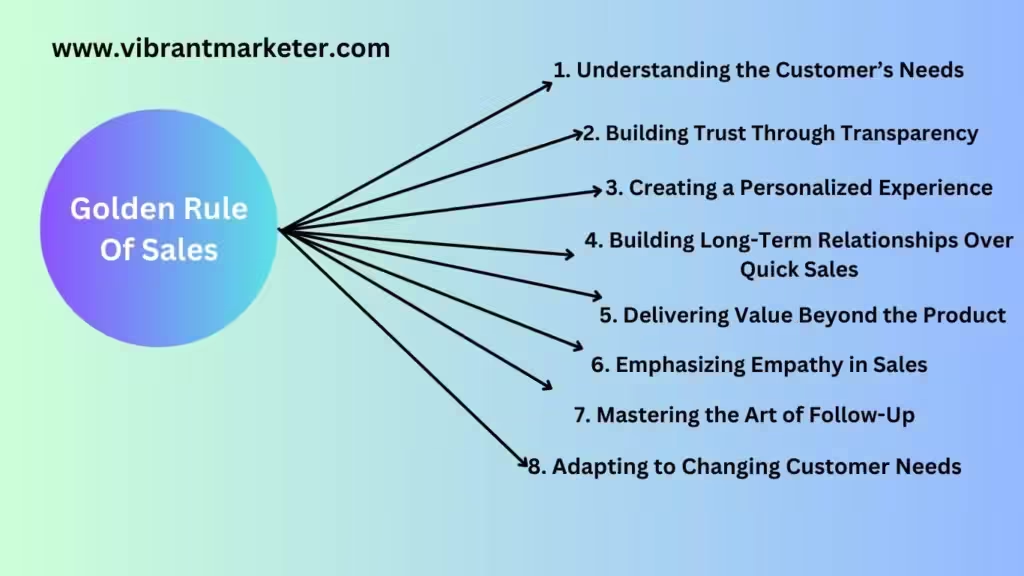
What is the Golden Rule of Sales?
What is the Golden Rule of Sales? with Examples, Tips and Case Studies

In Simple The Golden Rules of Sales are fundamental principles that guide sales professionals in effectively connecting with customers, building relationships, and closing deals.

1. Understanding the Customer’s Needs
What it is:
Good salesmanship begins with understanding what the customer truly wants or needs. This means actively listening, asking questions, and taking the time to learn about their problems, goals, and expectations. When a salesperson knows their customers well, they can tailor their approach to provide exactly what the customer is looking for.
Why it’s important:
Knowing the customer’s needs builds trust and shows them that you genuinely care. According to HubSpot’s State of Inbound Report, 69% of consumers expect brands to know their preferences. If you can show customers that you understand them, they are more likely to trust you and come back for future purchases.
How to do it:
- You Should Ask open-ended questions: Can Start with questions like, “What are you hoping to achieve with this product?” to get them engaged and talking.
- Practice active listening: Pay attention, make eye contact, and don’t interrupt.
- Follow up with solutions: Present products or services that directly address the customer’s needs.
Example:
Apple store employees are trained to ask about the customer’s lifestyle before suggesting a product. Instead of pushing a specific iPhone model, they ask how they use technology daily. This can make your customers feel heard and valued.
Tip from an Expert:
Howard Schultz, former CEO of Starbucks, once said, “We are not in the coffee business serving people, but in the people business serving coffee.” This reflects how listening and understanding customers’ needs go beyond the product itself.
2. Building Trust Through Transparency
What it is:
Transparency is about being honest and open about your product, including its limitations. When a salesperson is transparent, customers feel more comfortable and confident in their purchase.
Why it’s important:
Trust is the foundation of any relationship, including between customers and businesses. A survey by Edelman revealed that 81% of customers need to trust a brand to buy from them. Trust ensures repeat business and creates loyal customers.
How to do it:
- Be upfront about product limitations: If a product has limitations, let the customer know.
- Avoid overpromising: Stick to facts about the product’s benefits rather than exaggerating.
- Share real customer experiences: Testimonials and honest feedback from past customers can build credibility.
Case Study:
When outdoor gear brand REI found that customers returned certain hiking boots frequently due to discomfort, they began openly sharing this feedback with new buyers. Sales didn’t drop; instead, customer trust grew, as people appreciated the honesty.
Tip from an Expert:
Daniel Pink, author of To Sell is Human, explains, “Honesty builds credibility, and credibility is the bedrock of trust.” In his work, he emphasizes how being transparent makes customers feel safe to buy.
3. Creating a Personalized Experience
What it is:
Personalization in sales means treating each customer as unique. By tailoring the sales approach, recommendations, and even the messaging to match a customer’s preferences, salespeople can make the experience feel personal and memorable.
Why it’s important:
People remember experiences that feel tailored to them. Research has from Epsilon They found that 80% of consumers prefers to buy from a brand that offers personalized experiences. Personalization enhances customer satisfaction and loyalty.
How to do it:
- Use customer data wisely: Leverage any past purchase data to recommend relevant products.
- Adapt to customer preferences: Pay attention to how each customer likes to communicate, whether via phone, email, or face-to-face.
- Follow up personally: Send a personalized message post-purchase to thank the customer.
Example:
Sephora uses purchase history to suggest products that match a customer’s skin type or beauty routine. This makes customers feel valued and understood, increasing their likelihood of returning.
Tip from an Expert:
Brian Halligan, CEO of HubSpot, says, “Personalization is the future of marketing and sales.” He emphasizes that understanding a customer’s unique journey makes them more likely to trust the brand.
4. Building Long-Term Relationships Over Quick Sales
What it is:
Great salespeople focus on developing lasting relationships rather than just making a quick sale. This means keeping in touch with customers, following up, and showing appreciation for their business over time.
Why it’s important:
Long-term relationships increase customer loyalty and lead to repeat purchases. Studies from Bain & Company show that increasing customer retention by 5% can increase profits by 25-95%.
How to do it:
- Stay connected: Check in with customers periodically to show you care.
- Offer additional support: Be available to answer questions, even post-sale.
- Celebrate milestones: Recognize important moments, like anniversaries of their first purchase.
Example:
Nordstrom employees are known for remembering their loyal customers’ preferences and following up. This has led to an extremely loyal customer base for the brand.
Tip from an Expert:
Richard Branson, founder of Virgin Group, says, “Take care of your employees and customers, and they’ll take care of your business.” For him, customer relationships are about long-term loyalty, not one-off sales.
5. Delivering Value Beyond the Product
What it is:
Salesmanship isn’t just about selling a product; it’s about delivering value and solutions that go beyond what’s being purchased. This can include sharing useful advice, offering post-sale support, or providing industry insights.
Why it’s important:
When salespeople deliver extra value, they build a reputation as trusted advisors, not just salespeople. According to a Salesforce study, 79% of consumers say that personalized and valuable customer service significantly influences their loyalty.
How to do it:
- Offer industry knowledge: Share useful tips or trends that benefit the customer.
- Provide post-purchase guidance: Help customers get the most out of their purchase with tips and tricks.
- Follow up with useful resources: Share articles, videos, or other resources that could help them.
Case Study:
Insurance company Lemonade offers more than just policies—they educate customers on financial security and how to avoid common risks. This has made them a trusted name, especially among younger consumers.
6. Emphasizing Empathy in Sales
What it is:
Empathy in sales means understanding and sharing the feelings of customers.
Why it’s important:
Empathetic salespeople are more likely to build strong connections with customers. A study by Salesforce found that 70% of consumers are more likely to buy from a brand that understands them and their needs.
How to do it:
- Acknowledge customer feelings: Use phrases like “I understand how you feel” to validate their concerns.
- Respond appropriately: Tailor your responses based on the emotional cues from the customer.
- Provide reassurance: Let them know that you’re there to help solve their problems.
Example:
When customers express frustration over a product, an empathetic salesperson can say, “I can see why that would be frustrating. We can find a solution together.” This approach can fosters a supportive environment.
7. Mastering the Art of Follow-Up
What it is:
Following up with customers after the sale is crucial in salesmanship. It shows that you care about their experience and helps maintain the relationship.
Why it’s important:
According to Harvard Business Review, 80% of sales require five follow-up calls after the meeting. Following up increases the chances of repeat business and referrals, making it a valuable practice.
How to do it:
- Schedule follow-ups: Set reminders to check in with customers after their purchase.
- Ask for feedback: Inquire about their experience and if they have any questions or concerns.
- Provide additional resources: Share helpful content that relates to their purchase or interests.
Case Study:
Salesforce emphasizes the importance of follow-ups by showcasing companies that doubled their sales through diligent follow-up strategies. They found that customers appreciate being checked on, leading to stronger loyalty.
8. Adapting to Changing Customer Needs
What it is:
The ability to adapt to changing customer preferences and market trends is a hallmark of excellent salesmanship. This means being aware of what customers value and adjusting your sales strategies accordingly.
Why it’s important:
Markets evolve, and so do consumer needs. The Forrester Research report indicates that companies that adapt quickly to changing customer needs achieve a 25% higher customer retention rate.
How to do it:
- Stay informed about trends: Regularly read industry reports, customer feedback, and market research.
- Be flexible in your approach: Adjust your sales pitch or product recommendations based on current trends.
- Engage with customers on social media: Use social platforms to understand what customers are discussing and interested in.
Example:
During the COVID-19 pandemic, many companies, like Zoom, adapted their offerings to meet the sudden demand for remote communication. They adjusted their sales approach, emphasizing ease of use and flexibility, which helped them gain millions of new users.
Conclusion: What is the Golden Rule of Sales
In today’s competitive world, following the Golden Rule in salesmanship isn’t just ideal—it’s essential. Treating customers well builds a solid foundation for both business growth and personal success in sales.






